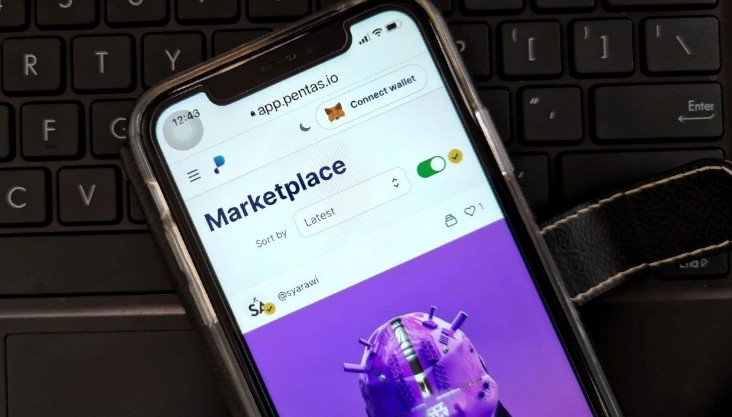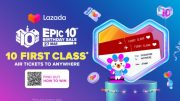If you want to become engaged in the local scene, there are six M’sian NFT marketplaces to check out
A marketplace for NFTs is a venue where people can buy and trade NFTs. OpenSea, Crypto.com, Rarible, Binance, and others are well-known.
The majority of those marketplaces are located in the global north, and I personally equate the NFT movement with western countries. Malaysia, on the other hand, is far from being behind. After all, it has already created a number of marketplaces.
However, just because it’s based in Malaysia doesn’t guarantee that your Ringgit will work on the majority of these services. You’ll still need a crypto wallet to mint, sell, and buy NFTs on these exchanges.
Many of the markets listed below use MetaMask, a cryptocurrency wallet that interacts with the Ethereum blockchain. As a result, ETH and ETH-based coins and tokens are supported.
1) Pentas.io

Pentas.io has quickly established itself as one of Malaysia’s most well-known marketplaces. The startup claimed earlier this year that in just six months, it had processed over 150K transactions.
PENTAS aspires to be an inclusive marketplace that tokenizes culture and tradition, but it also contains a wide spectrum of non-cultural NFTs. A brief glance through their feed reveals a diverse range of art and photography styles.
PENTAS runs on the Binance Smart Chain (BSC) and employs the Binance cryptocurrency, BNB, which, according to co-founder Irsyad Saidin, is a cheaper choice for customers than Ethereum despite its lesser popularity.
Digital artist Beeple sold an NFT on the Ethereum blockchain for US$69 million in 2021, skyrocketing the blockchain’s gas fees and making it more expensive to mint artwork on the Ethereum chain.
Users like badape, Rich Cats Nation, RoachPunks, and PandaPunkNFT, who are all confirmed creators on PENTAS, are among the top existing artists. According to PENTAS, verification is done on a case-by-case basis and is primarily for artists who are at danger of impersonation. You can learn more about their verification process here.
Artists are permitted to set a royalty rate for secondary sales of their collectibles.
At the time of writing, the current gas fee was 0.00117172 BNB (US$0.45).
The thorough vetting process is a standout feature.
2) NFT.my

The purpose of NFT.my (or NFT Malaysia), a collaboration between punks.my and the NFXT community, is to provide a platform that “makes it easier for the community to buy and sell NFTs on BSC.”
As a result, this platform has a 0% marketplace fee and pays royalties to artists on every transaction including their work.
However, only about 20 NFTs have been issued using this website. Instead, because it serves as an NFT aggregator for Malaysians, the marketplace is loaded with artwork created on other sites such as PENTAS.
NFT.my is a simple and straightforward platform where anyone can quickly search for NFTs and monitor market activity. It also offers a “Shill Zone” where people can market their NFTs, furthering NFT.my’s goal of being a “aggregator.”
At the time of writing, the current gas fee was 0.00117488 BNB (US$0.45).
NFT aggregation is a standout feature.
3) NFT Pangolin

Launched recently by MyEG, NFT Pangolin aims to be a global marketplace for regional creators to issue and sell NFTs. Unlike the above marketplaces, it uses Ethereum cryptocurrency.
As mentioned, Ethereum’s value makes minting more expensive, but according to NFT Pangolin’s FAQ, it supports lazy minting. It’s where artists can publish something for sale on NFT Pangolin, and the minting process will only be done when there is a confirmed transaction or purchase. This makes minting more cost-effective for both buyer and seller.
NFT Pangolin is also linked to OpenSea, meaning that anything published on NFT Pangolin will appear on OpenSea too. A portion of the minting fees charged to issuers on this site thus goes to OpenSea.
To create an NFT on this marketplace, you have to first fill out a contact form. There’s currently only a handful of featured creators on the platform including Vinn Pang, Momentum Alpha, and Johan Ishak.
Latest gas fees at time of writing: N/A.
Standout point: Easy, cost-effective minting.
4) TRART

TRART is “an international platform offering NFTs (non-fungible tokens) from well-known artists throughout the world,” according to its website.
TRART’s use of TRART coins is one of its distinguishing features. For RM13.90, 300 TRART coins are available. Users can use Maybank or Public Bank to top up their coins. TRART coins, on the other hand, appear to have no further uses outside of the platform.
NFTs on the market are currently priced between 100 and 2,000 TRART coins.
TRART also assists established artists who are new to the NFT community in converting real-world artwork to digital assets, including animation, digital effects, and more, according to its FAQ.
You must email the team in order to get your artwork posted on this site. Collections from well-known artists like Shaogao and comic publisher Kadokawa Gempak Starz are presently available on the platform.
At the time of writing, the following gas prices were in effect: N/A.
TRART tokens are used for platform transactions and can be topped up without the use of a crypto wallet.
5) NFTapir

This portal bills itself as “Malaysia’s first curated NFT Marketplace,” with the goal of creating and supporting a Malaysian artist ecosystem. The marketplace is definitely packed with artwork inspired by local architecture and locales, in keeping with its focus on the local.
NFTapir, which operates on the Polygon blockchain and allows “real gas-free minting,” was created to make NFTs more accessible to Malaysian artists. Because the gas fee is roughly US $0.01, the platform can absorb all of the fees by minting the NFT first and then sending it to the creator’s wallet.
“By enabling’real gas-free minting,’ we’re attempting to simplify the experience so that artists don’t have to go scout for tokens and figure out how to buy them from crypto exchanges,” stated co-founder Zang Tan to Vulcan Post.
NFTapir employs a “Phygital” mechanism, in which the platform converts physical artwork into NFTs, allowing collectors to purchase tangible art pieces in addition to the NFTs. As a result, many of the artists on this site focus on physical art.
This marketplace is still accepting new artists, however it currently features Chenyi, Lok Kerk Hwang, and Alex Leong.
At the time of writing, the current gas fee was 0.006559488 MATIC ($0.01).
The gas-free minting is a standout feature.
6) Artlab

Artlab, like NFTapir, integrates physical art with the digital NFTs. This marketplace, however, differs from the others in that the art is traded with fiat currency. In theory, Artlab is selling tangible artwork first, with NFTs as a bonus.
The benefit of having an NFT alongside the art, according to Founder Sebastian Jurkowski, is that everyone can view the whole ownership history and price, making art a liquid asset.
The lone creative on the platform for now is photographer heartpatrick, but Sebastian mentioned that he’s in the process of onboarding new artists the last time we spoke.





